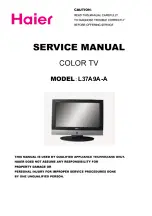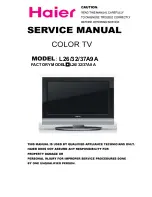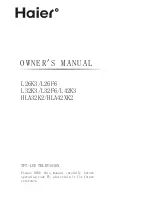
1. Cautions
When working, the unit is with ultra high voltage about 21.8KV inside. So, to avoid the risk of
electric shock, be careful to adjust the chassis!
1. Only qualified personnel should perform service procedures.
2. All specification must be met over line voltage ranger of 120V AC 60Hz.
3. Do not operate in WET/DAMP conditions.
4. Portions of the power supply board are hot ground. The remaining boards are cold ground.
5. Discharge of CRT anode should be done only to CRT ground strap.
6. When fuse blow, ensure to replace a fuse with the same type and specification.
7. Keep the wires away from the components with high temperature or high voltage.
8. When replacing the resister with high power, keep it over the PCB about 10mm.
9. The CRT anode high voltage has been adjusted and set in the factory. When repairing the
chassis, do not make the high voltage exceed 24.0KV (The beam current is 0uA). Generally,
the high voltage is set on 21.8KV
±
1.5KV (The beam current is 500uA).
* The values of parameters above are for information only.
10. Before return the fixed unit, do check all the covering of wires to ensure that not fold or not
short with any metal components. Check the entire protection units, such as control knobs,
rear cabinet & front panel, insulation resister & capacitor, mechanical insulators and so on.
11. There are some mechanical and electrical parts associating with safety (EMC) features
(Generally related to high voltage or high temperature or electric shock), these features cannot
be found out from the outside. When replace these components, perhaps the voltage and
power suit the requirements, but efficient X-ray protection may not be provided. All these
components are marked with
in the schematic diagram. When replace these, you’d
better look up the components listed in this manual. If the component you replaced not has the
same safety (EMC) performance, harmful X-ray may be produced.
TTE Overseas Support Department
Summary of Contents for 14DN2NYD
Page 41: ...5 Block Diagram TTE Overseas Support Department...
Page 42: ...6 Schematic Diagram...
Page 43: ...7 PCB Layout...
Page 44: ......
Page 45: ...8 Explode View Diagram...



































